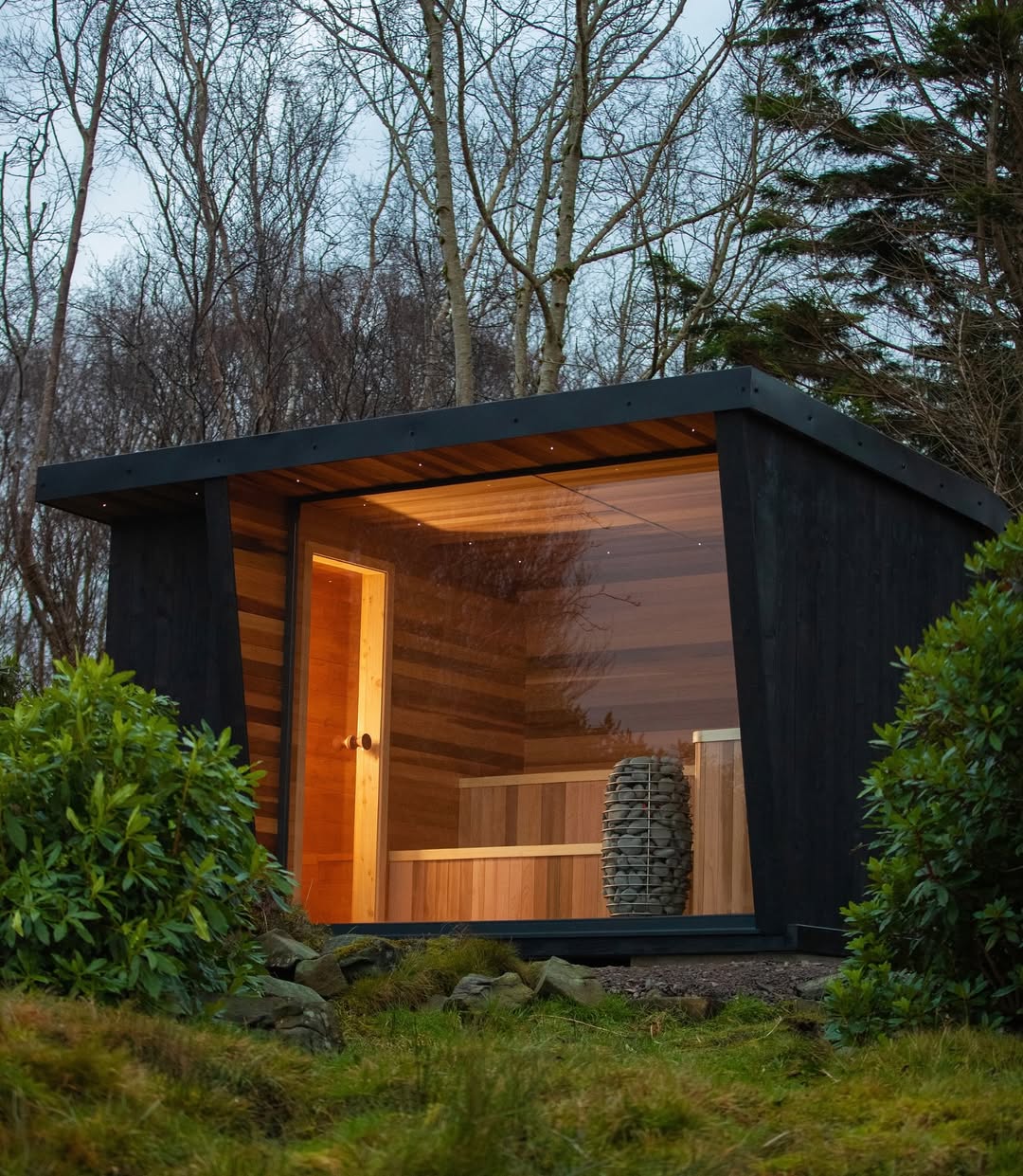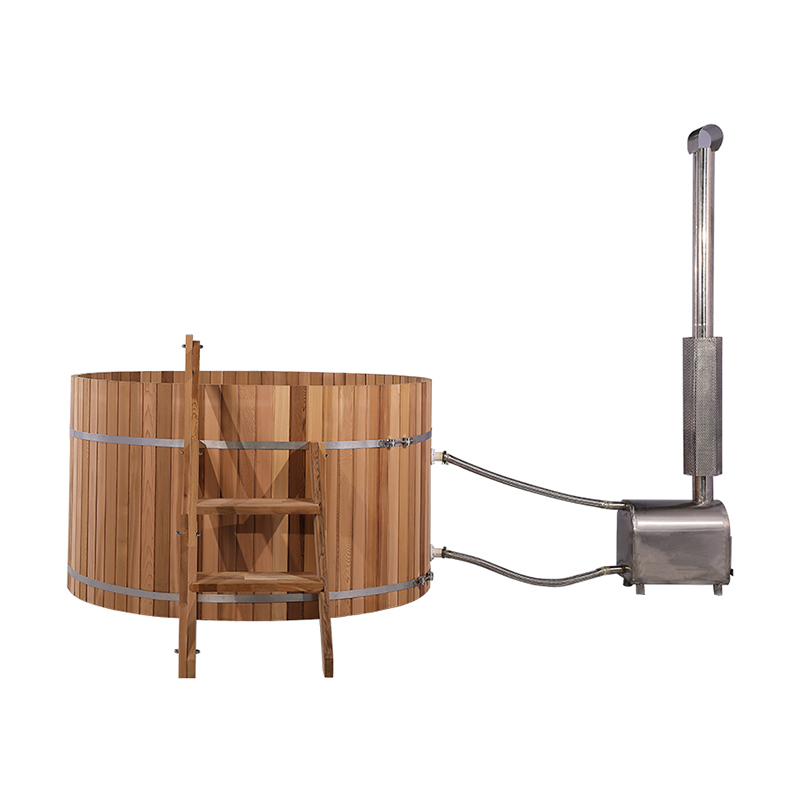Cedar is one of the most commonly used materials in sauna construction because it can withstand extremely humid environments, is naturally mold-resistant, resists insect attack, and has a long service life. In addition to these structural advantages, cedar also emits a pleasant smell that is loved by sauna architects and users. Although cedar is one of nature's most suitable woods for saunas, many modern saunas do not use cedar. However, in outdoor saunas and wood-burning saunas, cedar is still the first choice of sauna architects.

Below is one of our custom outdoor saunas built from cleaned western red cedar.
Why cedar is the wood of choice in sauna construction
Choosing the right wood is essential when building a sauna. You will thank yourself for choosing the right wood. Choosing a cheap wood may make you regret it later. Western Red Cedar is one of the most commonly used woods when building saunas. Although many people want to use cedar, when buying saunas online, very few sauna units are made with cedar. Why is this the case?
In fact, cedar is one of the most expensive woods. When compared to other commonly used sauna woods such as Canadian larch or Nordic white spruce, its price seems very high. In fact, the saunas of 97% around the world are built with non-cedar wood.
Despite this, it is still one of the most common questions we receive from customers looking to install a sauna.
Our custom saunas are made from cleaned Western Red Cedar and knotty Eastern White Cedar. For those who want a high-end designer look in their sauna, nothing beats perfectly cleaned cedar.
Why is cedar wood used in saunas?
The answer is simple, since cedar wood was discovered, it has proven to be one of the most suitable woods for saunas due to its natural resistance to moisture. Cedar wood has become one of the preferred woods for building saunas due to its aroma and soft, reddish appearance.
In addition to being able to withstand heat and humidity, cedar is also considered to have the best smell. While freshly cut pine may compete with cedar, cedar is often considered superior in aroma. All custom indoor or outdoor saunas we build can be made with cedar, or we offer cedar tongue and groove for DIY sauna builders.
Reasons to use cedar wood when building a sauna
In addition to its ability to naturally resist moisture, cedarwood has a long lifespan in high heat/humidity environments and has a pleasant smell. Many people like to use aromatherapy oils in their saunas to improve the smell, but I, like many, prefer the natural scent of cedarwood.
Personally, I have heard of many troubles that self-builders have had with saunas built with wood other than cedar. The problem ends up being that these woods crack due to the constant expansion and contraction in the sauna.
Should I use cedar wood throughout my sauna?
For those who have owned a sauna with cedar and modern building materials, we strongly recommend using cedar for both the interior walls of the sauna and the dressing room area. Due to its ability to absorb moisture without cracking and its naturally pleasant smell, cedar is the preferred wood that many architects choose to use in building saunas.
One disadvantage of using cedar is that it is expensive, especially if it is completely knot-free (i.e. completely clean). A common way to save money is to build the locker room area out of knotty cedar and the sauna interior out of clean cedar.
How does cedar prevent mildew in your sauna?
In a modern Finnish traditional steam sauna, a lot of heat and moisture is generated every time it is used. Cedar is one of the most suitable woods to prevent cracking, warping and moisture penetration, which can cause damage to other areas of the house.
Whether you use an electrically heated sauna heater or a wood burning sauna heater, cedar wood can withstand the tremendous humidity that occurs in a sauna with frequent use and lots of steam. Most frequent sauna users will pour gallons of water over the heater (yes, electric sauna heaters can also be filled with water).
How to Build a Sauna Using Cedar Wood While Saving Money
While the aroma that cedar provides is unmatched and makes it an ideal wood for building a sauna, it comes with a higher price tag. Cedar is one of the most expensive woods, and if you decide to use cedar when building your sauna and want to cut costs, here are some ways you can save money:
- Use other wood to build your seat
- Consider using different wood types for walls and ceilings
In a sauna, the seats will eventually need to be replaced, especially if the sauna is used frequently. Since you know the seats will eventually be replaced, why not use cheaper wood to build them? Larch, abach, poplar, alder, etc. are all cheaper options that can be used to build sauna seats.
It is also a good idea to consider using a variety of wood types for the walls and ceiling, especially for those who are building their own sauna. Two common wood types used in saunas are Nordic white spruce and cedar. Typically, the same wood will be used for the walls of the sauna, and if a different wood is to be used, it is usually used on the ceiling for a more finished look.
Why are tongue and groove wood panels used in saunas?
Sauna interiors almost always use tongue and groove construction. Tongue and groove wood is the preferred method in sauna construction because it maintains its form while allowing water to flow down the walls without penetrating the wall itself, where it could cause rot and other undesirable consequences.
If you are a DIY sauna builder, then choosing the wood for your tongue and groove construction is one of the most important decisions you will make during the construction process. Contact us to get a quote on the wood you need, we will be happy to answer any questions you may have during the sauna construction process!
Alternative materials to cedar
Although cedar is a very popular type of wood for sauna construction, it comes with a higher price tag. Since cedar is also one of the most expensive woods, many people consider using alternative materials. You might be surprised to learn that cedar is not actually the most commonly used wood for sauna construction.
White spruce and larch are actually the types of wood we use most often for the sauna kits we sell. In our many years of experience in sauna building, we have found that white spruce and larch wood are just as good as cedar, or even better. Please check out the indoor sauna and outdoor sauna options we offer, or contact us to get the wood for your sauna building.
Common alternatives to cedar include:
- White Spruce
- Larch
- Alder
- poplar
We offer many different types of wood that are designed specifically for saunas. If you have any questions about building or purchasing a sauna, please feel free to contact us, we have many years of sauna building experience and would be happy to help you with your sauna building journey!



